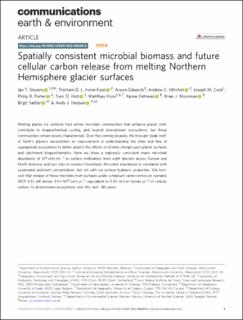| dc.contributor.author | Stevens, Ian T. | |
| dc.contributor.author | Irvine-Fynn, Tristram D. L. | |
| dc.contributor.author | Edwards, Arwyn | |
| dc.contributor.author | Mitchell, Andrew C. | |
| dc.contributor.author | Cook, Joseph M. | |
| dc.contributor.author | Porter, Philip R. | |
| dc.contributor.author | Holt, Tom O. | |
| dc.contributor.author | Huss, Matthias | |
| dc.contributor.author | Fettweis, Xavier | |
| dc.contributor.author | Moorman, Brian J. | |
| dc.contributor.author | Sattler, Birgit | |
| dc.contributor.author | Hodson, Andrew | |
| dc.date.accessioned | 2023-03-23T12:42:15Z | |
| dc.date.available | 2023-03-23T12:42:15Z | |
| dc.date.created | 2022-11-30T14:22:29Z | |
| dc.date.issued | 2022 | |
| dc.identifier.citation | Communications Earth & Environment. 2022, 3 (1), . | en_US |
| dc.identifier.issn | 2662-4435 | |
| dc.identifier.uri | https://hdl.handle.net/11250/3060130 | |
| dc.description.abstract | Melting glacier ice surfaces host active microbial communities that enhance glacial melt, contribute to biogeochemical cycling, and nourish downstream ecosystems; but these communities remain poorly characterised. Over the coming decades, the forecast ‘peak melt’ of Earth’s glaciers necessitates an improvement in understanding the state and fate of supraglacial ecosystems to better predict the effects of climate change upon glacial surfaces and catchment biogeochemistry. Here we show a regionally consistent mean microbial abundance of 104 cells mL−1 in surface meltwaters from eight glaciers across Europe and North America, and two sites in western Greenland. Microbial abundance is correlated with suspended sediment concentration, but not with ice surface hydraulic properties. We forecast that release of these microbes from surfaces under a medium carbon emission scenario (RCP 4.5) will deliver 2.9 × 1022 cells yr−1, equivalent to 0.65 million tonnes yr−1 of cellular carbon, to downstream ecosystems over the next ~80 years. | en_US |
| dc.language.iso | eng | en_US |
| dc.publisher | Nature Research | en_US |
| dc.rights | Navngivelse 4.0 Internasjonal | * |
| dc.rights.uri | http://creativecommons.org/licenses/by/4.0/deed.no | * |
| dc.title | Spatially consistent microbial biomass and future cellular carbon release from melting Northern Hemisphere glacier surfaces | en_US |
| dc.type | Peer reviewed | en_US |
| dc.type | Journal article | en_US |
| dc.description.version | publishedVersion | en_US |
| dc.rights.holder | © The Author(s) 2022 | en_US |
| dc.source.pagenumber | 10 | en_US |
| dc.source.volume | 3 | en_US |
| dc.source.journal | Communications Earth & Environment | en_US |
| dc.source.issue | 1 | en_US |
| dc.identifier.doi | 10.1038/s43247-022-00609-0 | |
| dc.identifier.cristin | 2085866 | |
| dc.source.articlenumber | 275 | en_US |
| cristin.ispublished | true | |
| cristin.fulltext | original | |
| cristin.qualitycode | 1 | |

